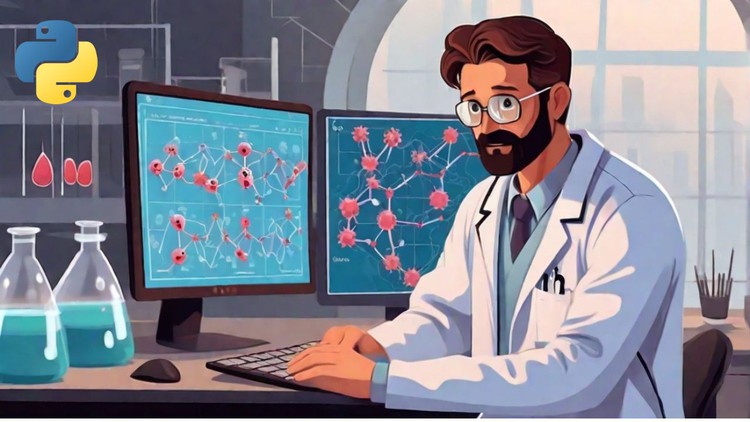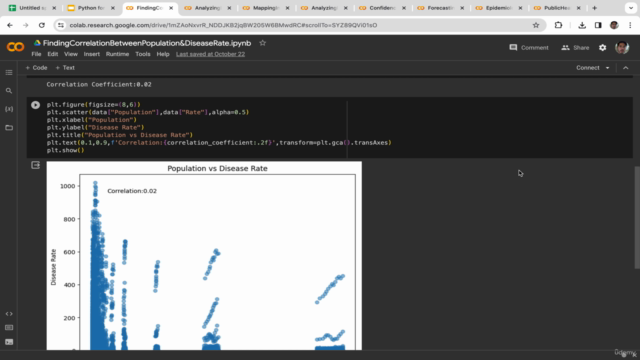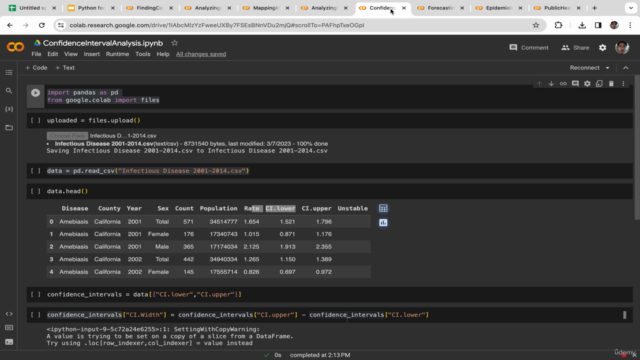Python for Biostatistics: Analyzing Infectious Diseases Data
Forecast infectious disease rate, build epidemiological modelling, and map the spread of infectious disease with heatmap
4.28 (16 reviews)

3 112
students
3 hours
content
Oct 2023
last update
$19.99
regular price
Why take this course?
📚 Python for Biostatistics: Analyzing Infectious Diseases Data
🚀 Course Headline: Forecast infectious disease rates, build epidemiological modelling, and map the spread of infectious diseases with heatmaps!
Course Description
Key Learning Areas:
1️⃣ Data Analysis
- Explore infectious disease datasets from various angles.
- Understand the nuances of biostatistics data and the challenges it presents.
2️⃫ Time Series Forecasting
- Learn the intricacies of the Seasonal Trend Decomposition (STL) model.
- Predict the spread of infectious diseases into the future.
3️⃣ Public Health Policy
- Craft data-driven public health policies informed by epidemiological modeling.
Introduction to Biostatistics Fundamentals:
In our introductory sessions, you'll get up to speed on:
- The core concepts of biostatistics, including common challenges and statistical models.
- The Kermack-McKendrick equation for calculating infectious disease transmission.
- Factors that can influence the spread of infectious diseases – population density, healthcare accessibility, and antigenic variation.
Hands-On Project:
As you've grasped the theoretical foundations, we'll move on to a hands-on project where you'll:
- Set Up Your Workspace: Learn how to configure the Google Colab IDE for your analysis.
- Data Acquisition: Discover how to source and download relevant datasets from platforms like Kaggle.
- Project Execution: Engage in three core components of the project:
- Exploratory Data Analysis (EDA): Dive into your dataset, identify patterns, and draw insights.
- Forecasting Model Building: Develop a model to predict future disease spread using time series techniques.
- Epidemiological Modeling & Public Health Policy Making: Apply the SIR model to understand disease dynamics and inform policy decisions.
Why This Course? 📈
- Career Advancement: If you're looking to break into or advance within the public health/healthcare industry, this course is invaluable.
- Versatile Skills: Acquire skills applicable beyond biostatistics, such as time series decomposition for various markets.
- Public Health Policy Expertise: Become adept at making informed decisions and considering external factors in public health policy creation.
What You'll Learn:
- Biostatistics Fundamentals: Gain a solid understanding of biostatistics and its application in infectious disease analysis.
- Infectious Disease Transmission Rate: Learn to calculate this critical metric using the SIR model.
- External Factors Analysis: Investigate how population density, herd immunity, and antigenic variation affect disease spread.
- Data Acquisition & Preparation: Find, download, and prepare datasets for analysis from platforms like Kaggle.
- Data Cleaning Techniques: Remove missing data, duplicates, and identify outliers using Z score.
- Demographic Analysis: Analyze patient demographics to inform interventions.
- Spatial Visualization: Map disease prevalence by county with heatmaps.
- Trend Analysis: Identify yearly trends in infectious diseases.
- Confidence Interval Analysis: Apply statistical methods to provide a range of possible values for your findings.
- Forecasting: Use time series decomposition models to forecast future disease rates.
- Epidemiological Modeling: Apply the SIR model to understand disease dynamics and inform interventions.
- Policy Evaluation: Assess the effectiveness of public health policies through data-driven analysis.
Embark on a journey to become proficient in biostatistical data analysis and make a tangible impact in public health with Python. Enroll in the Python for Biostatistics: Analyzing Infectious Diseases Data course today! 🎓
Course Gallery




Loading charts...
5623864
udemy ID
23/10/2023
course created date
27/10/2023
course indexed date
Bot
course submited by